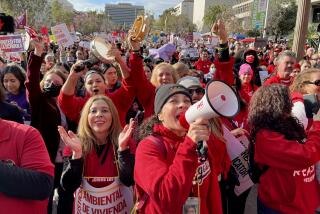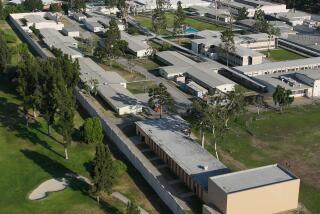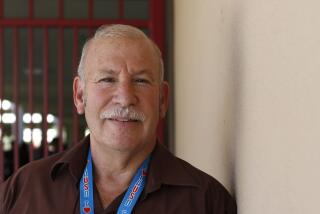Too many maverick moments finally led to Deasy’s undoing at LAUSD
The Los Angeles Unified School District dumped a heap of trouble on its schools this fall when it rolled out a new student records system.
The breakdown was the most severe at Jefferson High School in South Los Angeles. Seniors couldn’t get courses they needed to graduate. Others had to sit in classes they had already passed. Hundreds waiting for a complete class schedule crammed into the school auditorium for up to three weeks.
In this moment of crisis, L.A. schools Supt. John Deasy came up with a novel response, one that positioned him where he had been many times before: flying solo, beyond the control of his elected bosses on the school board, campaigning for reform on a high-profile platform.
Without the knowledge of board members, Deasy prepared a sworn statement in a court case that attacked scheduling practices in L.A. Unified and other districts, citing Jefferson as an example of what was going wrong.
Deasy’s declaration irked some school board members and the judge in the court case, who wondered why Deasy didn’t take charge of the problem in his own school system.
By then, Deasy’s bosses on the L.A. school board had endured enough of his maverick moments. They sent their attorney on a mission to reach out to former Supt. Ramon C. Cortines, who had led the district before Deasy.
The talks had to remain secret because there had been past tensions between the two, and board members didn’t want Deasy to know they were courting Cortines.
The lawyer posed the big question: Would the 82-year-old Cortines consider coming out of retirement?
::
Deasy’s 3 1/2 years as head of the nation’s second-largest school district ended with his resignation last week, but his path was unusual from the very outset of his tenure at L.A. Unified.
Not the product of a nationwide or local search, Deasy instead was installed as the heir apparent, taking the No. 2 job under Cortines with every expectation he would soon be in charge.
Then-Mayor Antonio Villaraigosa, who had staked considerable political capital on improving low-performing schools, was among those who quietly demanded that Deasy take over. His previous post had been as a deputy director with the Bill & Melinda Gates Foundation. He’d also served as superintendent in Santa Monica-Malibu Unified and Prince George’s County Public Schools in Maryland.
Deasy said from the outset that he would use any means necessary — including supporting legislation and outside litigation — to pursue his vision of what would propel gains in student achievement. His sense of urgency was heightened, he said, by the poverty and low academic skills he saw in Los Angeles.
The superintendent repeatedly proved true to his word — most notably earlier this year, when he testified in a groundbreaking court fight that stripped teachers of some key traditional job protections. He wanted to make it easier to remove ineffective teachers in the name of promoting student civil rights. Deasy had his staff devote considerable time to Vergara vs. California before he spent three days on the witness stand.
“I was the only sitting superintendent to participate in the Vergara case and there is a reason for that,” Deasy said at the time. “I am taking a risk, but I feel the issue is too important to sit out.”
An angry backlash from teachers proved his words prophetic. He also didn’t endear himself to members of the Board of Education by proceeding without their approval. (The lawsuit succeeded at trial and is on appeal.)
Deasy’s desire to be the vanguard of change also had found expression in his bid to provide iPads for every student — pledging that he would close the technology gap with the state’s more privileged children.
The school board unanimously went along, with little discussion and no dissension, until problems ensued with the rollout last year and questions recently emerged about the bidding process.
Months before bidding began, for example, Deasy made a promotional video for Apple, talking about the wonders of the iPad. That endorsement and other statements and actions gave the appearance, to critics, of a single-minded rush toward one product, which troubled some board members and financial overseers. They pointed out how other districts brought technology to students at lower cost or without using school construction bonds.
Deasy insisted no wrongdoing had occurred and said he had sat out the formal bidding process. The troubled iPad initiative — with students accessing forbidden sites and officials misstating costs — enhanced a portrait of Deasy as the big-picture advocate who was too passionate, or distracted, to attend to details.
Many rank-and-file employees came to view him another way: as imperious and punitive, always demanding more from teachers and administrators even when budget cuts resulted in larger classes and fewer resources.
Nonetheless, he remained the darling of a community of philanthropists and proponents of a certain style of education reform that borrows heavily from the principles of private enterprise.
They applauded his push for a teacher evaluation system that incorporated student standardized test scores, and that he fired teachers identified as poor performers in greater numbers than before.
Deasy’s path was made more difficult because he never had a solid majority on the Board of Education. His supporters tried, and failed, to elect newcomers who would give him broad latitude. Four pro-Deasy candidates lost over two election cycles, resulting in a board majority that would not unreservedly follow his lead.
Those officials also felt that Deasy ignored their directives and treated them dismissively. “It was clear that he thought he was the smartest person in the room,” said one senior district official, a comment echoed by others.
And he wasn’t the most patient, diplomatic or strategic leader, something that even Deasy has acknowledged.
Deasy threatened at least twice to leave the district. In the summer of 2013 the superintendent tried the tactic to prevent the elevation of Richard Vladovic to board president. The effort failed.
All the while, test scores continued to improve, as did graduation rates. By those two crucial measures, the superintendent, and students, appeared to be winning.
But for the board majority, Deasy had become an uncommunicative, ungovernable, somewhat detached leader. It didn’t help that he became a target for the teachers union to rally against in its push for a better contract.
Instead of looking for ways to unite behind Deasy, board members — unhappy with their leader — began looking for reasons or justifications to push him aside.
The recent crises over technology programs — first the iPad and then the student records system — gave them a rationale they could, if necessary, defend in public.
The board had additional leverage over Deasy. His regular performance evaluation was set for next Tuesday. Anything less than a positive rating would place his reputation under a bigger cloud if he did not step aside.
For their part, board members began to see Cortines as an irresistible balm for a leadership crisis, sources said. He’d been in occasional touch since his retirement in 2011. At least three board members began to talk to him in the latter part of September, getting his advice and sounding out whether he might consider an interruption in his retirement.
Cortines initially said no. Then he said an official request would have to be made on behalf of the board.
That happened after Deasy filed his court declaration attacking L.A. Unified’s scheduling practices.
Next, Cortines insisted on a unanimous vote.
“This is not about me,” Cortines said in an interview. “This is about making a statement to the community that the superintendent, whoever it is, and the board are going to make every effort to work together.”
Meanwhile, the board was negotiating more intensely with Deasy, who had retained an attorney.
Deasy received a few concessions, including an arrangement that keeps him on the payroll through the end of the year. The school board also agreed to a departure announcement that celebrated his accomplishments and indicated their confidence that Deasy would be exonerated of any wrongdoing related to the iPads-for-all program.
In 7 1/2 hours of closed meetings last Tuesday, the board reached its final terms with Deasy and gave Cortines a unanimous offer, which Cortines said he never expected to be possible.
“I might have had a different strategy for responding to them,” he said with a laugh, “if I thought this would ever happen.”
More to Read
Start your day right
Sign up for Essential California for news, features and recommendations from the L.A. Times and beyond in your inbox six days a week.
You may occasionally receive promotional content from the Los Angeles Times.








